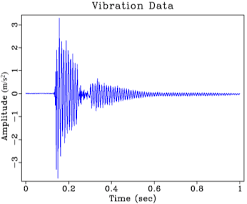As part of a research project I will be load testing a beam in my school lab. I have been asked to try and determine the damping of the beam as part of this project and I was considering conducting a modal impact test. I am not very familiar with structural dynamics and wanted the opinion of those more experienced. The span of the simply supported beam is about 3.3 metres and it is 300mm in depth.
I do not have the funding to rent or buy a proper modal impact hammer. Therefore, if I were to conduct this test I would be striking the beam with a regular hammer while ONLY measuring the acceleration of the beam. I recognize that you should have a load cell on the hammer head in order to determine the impact duration and magnitude for proper modal analysis. However I would like to know how much inaccuracy would I be introducing if I were to only measure the output accelerations? I realize I would not be able to produce a coherence plot in order to check the quality of my data. However, I am primarily only concerned with accurate identification of the first mode of vibration and I would be looking to verify the first natural frequency and produce a corresponding estimate of the damping ratio. I am thinking of placing the accelerometer at mid-span of the beam and I would strike with the hammer only at mid-span. This would be done to ensure that data for the first mode shape is the most accurate. I would conduct this test maybe 5-10 times and take the average results in order to help reduce the error due to noise and inaccuracies from differing pulse durations.
Any comments you can provide would be greatly appreciated. I am not familiar with this method of analysis and I am learning as I go. I realize that my data using this method may not be the most accurate but I would like to provide reasonable values for minimal cost as this is simply an addition to the main purpose of my research. Any insight, resources and comments you can provide would be greatly appreciated!
I do not have the funding to rent or buy a proper modal impact hammer. Therefore, if I were to conduct this test I would be striking the beam with a regular hammer while ONLY measuring the acceleration of the beam. I recognize that you should have a load cell on the hammer head in order to determine the impact duration and magnitude for proper modal analysis. However I would like to know how much inaccuracy would I be introducing if I were to only measure the output accelerations? I realize I would not be able to produce a coherence plot in order to check the quality of my data. However, I am primarily only concerned with accurate identification of the first mode of vibration and I would be looking to verify the first natural frequency and produce a corresponding estimate of the damping ratio. I am thinking of placing the accelerometer at mid-span of the beam and I would strike with the hammer only at mid-span. This would be done to ensure that data for the first mode shape is the most accurate. I would conduct this test maybe 5-10 times and take the average results in order to help reduce the error due to noise and inaccuracies from differing pulse durations.
Any comments you can provide would be greatly appreciated. I am not familiar with this method of analysis and I am learning as I go. I realize that my data using this method may not be the most accurate but I would like to provide reasonable values for minimal cost as this is simply an addition to the main purpose of my research. Any insight, resources and comments you can provide would be greatly appreciated!

![[thumbsup2] [thumbsup2] [thumbsup2]](/data/assets/smilies/thumbsup2.gif)
